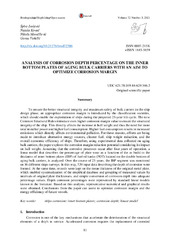Приказ основних података о документу
Analysis of corrosion depth percentage on the inner bottom plates of aging bulk carriers with an aim to optimize corrosion margin
| dc.creator | Ivosević, Spiro | |
| dc.creator | Kovac, Nataša | |
| dc.creator | Momčilović, Nikola | |
| dc.creator | Vukelić, Goran | |
| dc.date.accessioned | 2022-09-19T19:12:17Z | |
| dc.date.available | 2022-09-19T19:12:17Z | |
| dc.date.issued | 2021 | |
| dc.identifier.issn | 0007-215X | |
| dc.identifier.uri | https://machinery.mas.bg.ac.rs/handle/123456789/3481 | |
| dc.description.abstract | To ensure the better structural integrity and maximum safety of bulk carriers in the ship design phase, an appropriate corrosion margin is introduced by the classification societies, which should enable the exploitation of ships during the projected 25-year life cycle. The new Common Structural Rules introduce even higher corrosion margin value to ensure the structural integrity of the ship. This directly affects the increase in hull weight and thus the need for more total installed power and higher fuel consumption. Higher fuel consumption results in increased emissions which directly affects environmental pollution. For these reasons, efforts are being made to introduce alternative energy sources, cleaner fuel, ship weight reduction, and the overall economic efficiency of ships. Therefore, using experimental data collected on aging bulk carriers, the paper explores the corrosion margin reduction potential considering its impact on hull weight. Assuming that the corrosive processes occur after four years of operation, a linear model that describes the percentage of plate wear as a function of the as build-in the thickness of inner bottom plates (IBP) of fuel oil tanks (FOT) located on the double bottom of aging bulk carriers, is analyzed. Over the course of 25 years, the IBP segment was monitored on 36 different ships surveys. In this way, 520 input data describing the depth of corrosion were formed. At the same time, records were kept on the mean thickness of the original metal plate, which enabled systematization of the empirical database and grouping of measured values by intervals of original plate thicknesses, and simple conversion of corrosion depth into adequate percentage values. Depth corrosion percentages were represented by standard linear models known in the literature. Based on this analysis, representative numerical and graphical results were obtained. Conclusions from the paper can assist to optimize corrosion margin and the energy efficiency of future vessels. | en |
| dc.publisher | Univ Zagreb Fac Mechanical Engineering & Naval Architecture, Zagreb | |
| dc.relation | Thickness Measurement Company - INVAR-Ivosevic Company | |
| dc.rights | openAccess | |
| dc.rights.uri | https://creativecommons.org/licenses/by/4.0/ | |
| dc.source | Brodogradnja | |
| dc.subject | ships corrosion | en |
| dc.subject | linear model | en |
| dc.subject | inner bottom plates | en |
| dc.subject | corrosion depth | en |
| dc.title | Analysis of corrosion depth percentage on the inner bottom plates of aging bulk carriers with an aim to optimize corrosion margin | en |
| dc.type | article | |
| dc.rights.license | BY | |
| dc.citation.epage | 95 | |
| dc.citation.issue | 3 | |
| dc.citation.other | 72(3): 81-95 | |
| dc.citation.rank | M23 | |
| dc.citation.spage | 81 | |
| dc.citation.volume | 72 | |
| dc.identifier.doi | 10.21278/brod72306 | |
| dc.identifier.fulltext | http://machinery.mas.bg.ac.rs/bitstream/id/2074/3478.pdf | |
| dc.identifier.scopus | 2-s2.0-85116500156 | |
| dc.identifier.wos | 000704175100006 | |
| dc.type.version | publishedVersion |


